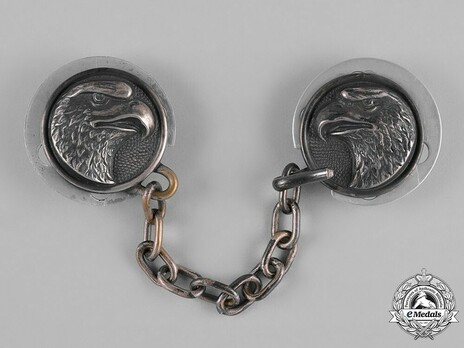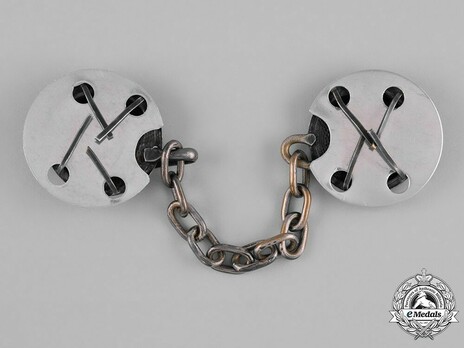Luftwaffe Officer Ranks Cape Clasp
CATEGORY: Version
SKU: 22.GOR.02.01.05.002.000
Estimated market value:


Estimated market value:
Constructed of silvered bronze, with two clasps bearing a stylized and richly-detailed Luftwaffe-style eagle’s head, each measuring 37 mm in diameter, attached to backers with four malleable reverse prongs, connected by a 110 mm-long chain, unmarked, in extremely fine condition.
The German Wehrmacht was composed of three main branches, the Heer, the Kriegsmarine, and the Luftwaffe. The Heer and Kriegsmarine uniforms were based upon the designs utilized by their predecessor organizations, the Deutsches Heer and the Kaiserliche Marine. Conversely, the Luftwaffe uniforms were based upon the uniforms worn in the sports and para-military organizations that were the forerunners of the Luftwaffe. The Luftwaffe uniforms were specifically designed to deviate from the designs of the other Wehrmacht service branches. It was also necessary that the uniforms differentiate between military and civilian pilots.
There were two main organizational precursors of the Luftwaffe, the German Air Sports Association (DLV or Deutscher Luftsportverband), and the National Air Raid Protection League (RLB or Reichs Luftschutzbund). The DLV included both a civilian group and a secret military sub-group called the DLV-Fliegerschaft (Pilot Base).
The DLV and the RLB were officially founded in 1933, and they were used to secretly train members for future roles in the Luftwaffe. The DLV became obsolete after Hitler’s official introduction of the Luftwaffe in 1935, and it was disbanded in 1937.
Luftwaffe Capes were closed in the front by a so-called Spanierschloss (Spanish buckle) in the form of two metal discs depicting an eagle’s head, connected by a chain. The eagle’s heads are facing towards each other. The chain is made up of ten or eleven links.
Initially, the discs were made of dark silver-oxidized metal for officer ranks and brass for general ranks. This was changed in 1937 to silver-oxidized or gold-coloured light metal alloy in 1937.

Comments
Sign in to comment and reply.


Scroll Top